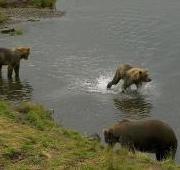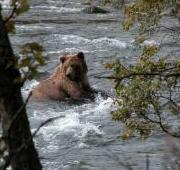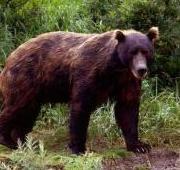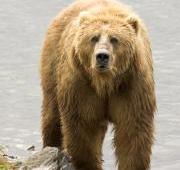 Brown Bears are found in many parts of North America and Eurasia, where the bears inhabit wooded and mountainous areas. The brown bear is also the national animal for a number of states in North America, Europe and Asia.
Brown Bears are found in many parts of North America and Eurasia, where the bears inhabit wooded and mountainous areas. The brown bear is also the national animal for a number of states in North America, Europe and Asia. Brown bears tend to feed on vegetation, fish and small land mammals, but the bears will only occasionally hunt bigger mammals like deer. Brown bears dont seem to be a great threat towards humans, although the mother brown bears will protect their young bear cubs.
Brown bears tend to feed on vegetation, fish and small land mammals, but the bears will only occasionally hunt bigger mammals like deer. Brown bears dont seem to be a great threat towards humans, although the mother brown bears will protect their young bear cubs.


The brown bear is an extremely dominant predator in its environment, with only threats from human hunters posing any real dominance over the brown bears predatory rights. The brown bear has an enormous muscle between the brown bears shoulder blades that makes the brown bear stand out above other bear species.
The enormous shoulder muscle that the brown bear has means that the brown bear has immensely strong forearms and allows the bear to break animal bones with one simple swipe. The brown bear has massive paws with claws that can grow longer than 15cm in length.
There are thought to be around 200,000 brown bear individuals left in the wild over half of which are found in Russia. Around 95% of the brown bear population found in the USA is in the northernmost state of Alaska. Most of the brown bears that inhabit regions of Canada are found in the west of the country in the Rocky Mountain range.
Brown Bear Foot Facts
- The brown bear has four large paws and each of the paws of the brown bear has five toes that result in long claws.
- The two front paws of the brown bear have toes that have longer claws than on the back paws, as the brown bear uses its front paws for digging.
- The two back paws of the brown bear are larger than the two front paws as the brown bear often stands on its hind legs to either survey their surroundings or to get food out of higher places.
- The brown bear uses its front paws with their enormous claws to rip open logs that have bugs inside so that it can eat them.
- The brown bear uses its specially structured paws and legs in order to help it run fast, climb trees and swim well.
Brown Bear Teeth Facts
- Brown bears do not normally bite their prey but instead grind and crunch with their enormous teeth to get their meal into them.
- The brown bear has approximately 42 teeth including large predatory teeth that the brown bear uses to shred meat and skin.
- The brown bear uses both its large, strong paws and its sharp teeth to catch and kill its prey and will either bite the neck of the animal or swipe it with its immense forearms.
- The molar teeth of the brown bear increase in size as they go further in the mouth of the brown bear and the brown bear predominantly uses its largest molar to grind up tough food.
- The size of the teeth of the brown bear are dependant on the size of the bear itself, so bigger bears will have bigger teeth than smaller bears.

